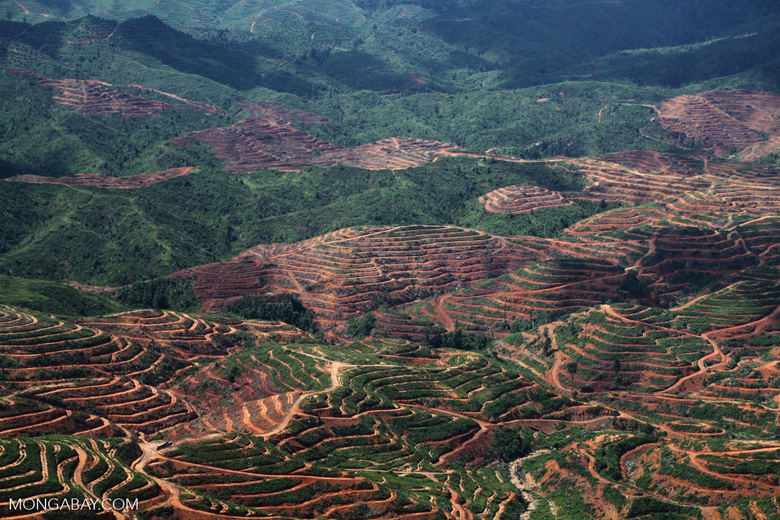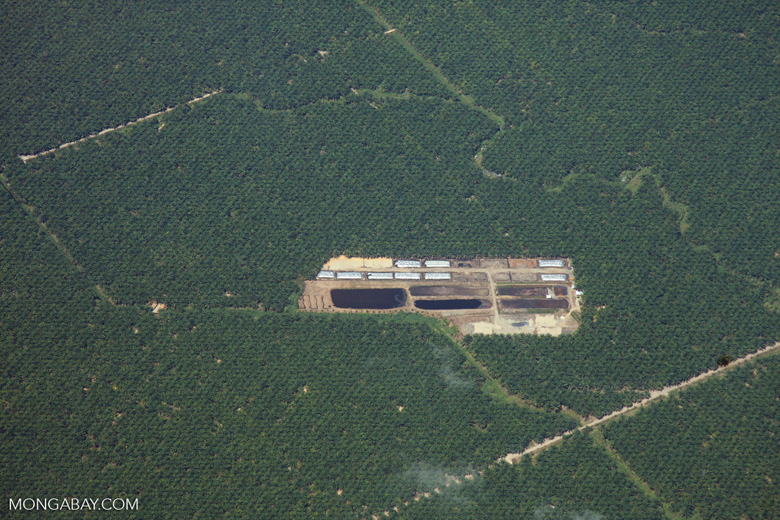- Palm oil plantation expansion has led to widespread deforestation in tropical countries like Indonesia and Malaysia.
- The PALM Risk Tool uses historical tree cover loss data and mill locations to gauge the deforestation risk level of more than 800 palm oil processing mills.
- Its creators say it can be used by companies that want to keep tabs on the sustainability of their palm oil sources.
Palm oil – an ingredient in products from lipstick to cookies to soap – started its journey to ubiquity in the rainforests of western Africa. Squeezed from fruit of the oil palm tree (Elaeis guineensiss), palm oil has long been used as a traditional cooking oil by local communities. Then, in the 1800s, it became a sought-after international commodity as the rise of the Industrial Revolution in Europe improved hygiene practices and spurred a consequential demand for soap. Since then, cultivation of oil palm has exploded and the epicenter of industrial production relocated to Indonesia and Malaysia, which saw the production of 85 percent of the global palm oil supply in 2013. Between 1967 and 2000, the area cultivated for palm oil grew from 2,000 square kilometers to 30,000 square kilometers in Indonesia alone.
This expansion has attracted the criticism of conservationists and scientists who lament the industry’s environmental repercussions. Today, much of the world’s palm oil is produced on vast plantations, many of which have displaced native rainforest – and the wildlife therein. Sumatran orangutans (Pongo abelii) have declined some 80 percent as their forest habitat is whittled away. Sumatran tigers (Panthera tigris sumatrae) are facing similar pressures, losing between 3 and 6 percent of their habitat every year. Both are now considered critically endangered by the IUCN, with palm oil plantations listed as among the biggest threats to their survival.

Land conversion can also be dangerous for human communities. The wildfire crisis that smoked out Indonesia and neighboring Singapore and Malaysia last fall was precipitated in large part by the draining and drying of Indonesian peat forest for agricultural purposes, as well as slash-and-burn clearing techniques. Millions of people were affected by the dangerous haze, more than 140,000 reported respiratory infections, and at least 29 died from resultant illness.
In response, government and private sectors have been trying their hands at quelling the tide of industrial agriculture and preserving what forest remains. Indonesia has declared various moratoria on development in the country, including a recent ban on new palm oil and mining concessions in its Leuser Ecosystem – the last place on earth where elephants, tiger, orangutans, and rhinos are found together. More than 300 companies that use palm oil in their products have also issued commitments to buy only from “deforestation-free” producers by 2020.
But with each company often sourcing its palm oil from hundreds of processing mills, which, in turn, get their fruit from thousands of local producers, it can be tricky to figure out if a mill really is providing palm oil grown on already-degraded land. To help clarify things, the World Resources Institute (WRI) banded together with NGOs Proforest and Daemeter to analyze deforestation trends around palm oil mills in producer countries like Malaysia and Indonesia, and see if they could use those trends to predict the risk of future forest loss.


The project centered on two main assumptions: that previous deforestation can be used to forecast future deforestation, and that processing mills get their fruit from plantations and farms within 50-kilometer radii (the average distance palm fruit can be transported before spoiling). The analysts then looked at satellite-detected tree cover loss data within those areas to assign risk values to each mill.
Their result is a new dataset called the PALM Risk Tool that shows tree cover loss trends surrounding 800 palm oil processing mills around the world. The analysts hope it can be used by companies to trace the impacts of their supply chains. The tool was publicly debuted yesterday via WRI’s online forest monitoring platform Global Forest Watch.
“This is a great example of how data and transparency can drive impact,” said Crystal Davis, Director of Global Forest Watch. “This tool combines previously unavailable data on where palm oil mills are located around the world and cutting edge satellite monitoring technology to show companies exactly where they should focus their efforts to achieve their sustainability goals. It won’t happen overnight, but this tool can point companies in the right direction.”
To test it out, WRI partnered with consumer goods company Unilever, finding that 29 of the mills from which the company sources its palm oil are at high risk of deforestation. One of these mills is Intan Sejati Andalan mill in Riau, Indonesia. The land surrounding the mill has lost more than 200,000 hectares of primary forest since 2009, and the analysts expect the remaining 300,000 hectares have a good chance of being cleared, as well. Among the areas threatened by palm oil are Giam Siak Kecil and Balai Raja wildlife reserves, which are home to critically endangered Sumatran rhinos, elephants, and clouded leopards.
The Sawitta Jaya Lau Pakam mill in northern Sumatra sits in a valley right between the two lobes of the Leuser Ecosystem – near a portion protected as a national park and a UNESCO World Heritage Site. Analysis by the PALM Risk Tool finds that within its 50-kilometer radius, around 7 percent — 47,000 hectares — of its tree cover was lost between 2001 and 2014. Of that, 11,300 hectares was primary forest and 7,600 hectares were lost from protected areas. While the tool lists the mill as a “Medium-Low” risk for general future deforestation, it is listed as high risk for deforestation in protected areas.


The Roundtable on Sustainable Palm Oil (RSPO), the world’s biggest industry watchdog, has high hopes that the new dataset will aid companies looking to get their palm oil from more sustainable sources.
“The RSPO welcomes any effort that can help curb deforestation,” said Darrel Webber, RSPO Secretary General. “This is why the RSPO recently launched RSPO NEXT, a set of additional criteria for palm oil production to help companies back up their no deforestation policies. By combining the risk map analysis provided by PALM Risk Tool and purchasing palm oil from RSPO NEXT-verified growers, companies will be sure that their supply chain is certified sustainable.”
Disclaimer: Mongabay has a funding relationship with the World Resources Institute (WRI). However, WRI has no editorial input.
